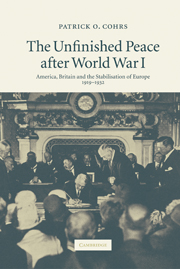Book contents
- Frontmatter
- Contents
- Acknowledgements
- List of abbreviations
- A note on the footnotes and bibliography
- Introduction
- Prologue
- 1 The wider challenges
- 2 Wilson, Lloyd George and the quest for a ‘peace to end all wars’
- 3 The ill-founded peace of 1919
- 4 The escalation of Europe's post-Versailles crisis, 1920–1923
- Part I The Anglo-American stabilisation of Europe, 1923–1924
- Part II Europe's nascent Pax Anglo-Americana, 1924–1925
- Part III The unfinished transatlantic peace order: the system of London and Locarno, 1926–1929
- 17 Sustaining stability, legitimating peaceful change
- 18 Progressive visions and limited commitments
- 19 ‘Reciprocity’?
- 20 The new European concert – and its limits
- 21 Thoiry – the failed quest for a ‘final postwar agreement’
- 22 Towards peaceful change in eastern Europe?
- 23 Achievements and constraints
- 24 No ‘new world order’
- 25 The initiation of the Young process
- 26 The last ‘grand bargain’ after World War I
- Epilogue
- Conclusion
- Map: Post-World War I Europe after the peace settlement of Versailles
- Bibliography
- Index
24 - No ‘new world order’
The limits of the Kellogg–Briand pact
Published online by Cambridge University Press: 21 July 2009
- Frontmatter
- Contents
- Acknowledgements
- List of abbreviations
- A note on the footnotes and bibliography
- Introduction
- Prologue
- 1 The wider challenges
- 2 Wilson, Lloyd George and the quest for a ‘peace to end all wars’
- 3 The ill-founded peace of 1919
- 4 The escalation of Europe's post-Versailles crisis, 1920–1923
- Part I The Anglo-American stabilisation of Europe, 1923–1924
- Part II Europe's nascent Pax Anglo-Americana, 1924–1925
- Part III The unfinished transatlantic peace order: the system of London and Locarno, 1926–1929
- 17 Sustaining stability, legitimating peaceful change
- 18 Progressive visions and limited commitments
- 19 ‘Reciprocity’?
- 20 The new European concert – and its limits
- 21 Thoiry – the failed quest for a ‘final postwar agreement’
- 22 Towards peaceful change in eastern Europe?
- 23 Achievements and constraints
- 24 No ‘new world order’
- 25 The initiation of the Young process
- 26 The last ‘grand bargain’ after World War I
- Epilogue
- Conclusion
- Map: Post-World War I Europe after the peace settlement of Versailles
- Bibliography
- Index
Summary
On 6 April 1927, marking the tenth anniversary of America's entry into the Great War, Briand made a statement to the Associated Press proposing a bilateral pact of perpetual peace between France and the United States. Positing that the two ‘great democratic nations’ were inspired by an ‘identity of aims’ in their peace policies, he declared that they should set an example to the world by signing a treaty committing both to ‘the renunciation of war as an instrument of national policy’. More than two months passed before Kellogg signalled, on 11 June, that the Coolidge administration was willing to ‘enter into diplomatic conversations’ about Briand's proposal. Ten days later, Washington received a formal note with the French draft treaty.
Thus, a complex process of transatlantic negotiations was set in motion, which went on for more than a year and evolved from ‘soundings’ between Paris and Washington to a series of ‘multilateral’ exchanges, which were largely steered by the US State Department. At its end, on 27 August 1928, the United States concluded, not a bilateral treaty with France but a multilateral pact signed not only by all Locarno powers and their European neighbours to the east (though the Soviet Union abstained) but also by Japan and a plethora of other states.
From the outset, Kellogg had suspected that Briand's plan amounted to ‘a defensive treaty with France’ that would allow Paris to buttress the postwar status quo and ‘leave it open to her to take what action she liked in Europe’ while ensuring Washington's ‘neutrality’.
- Type
- Chapter
- Information
- The Unfinished Peace after World War IAmerica, Britain and the Stabilisation of Europe, 1919–1932, pp. 448 - 476Publisher: Cambridge University PressPrint publication year: 2006



